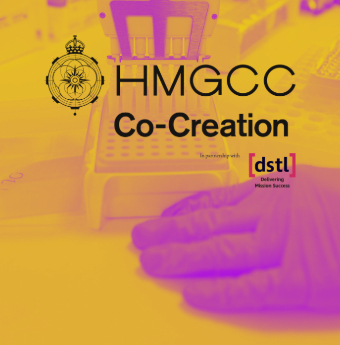HMGCC Co-Creation Challenge: DNA Removal to Cut Cross-Contamination Risk
Closing: 18 September 2025
Summary of Challenge
Techniques to decontaminate forensics lab tools of biological traces are being sought in the latest challenge launched by HMGCC Co-Creation.
The team are looking for effective solutions for cleaning DNA from tools, surfaces and instruments, used in forensic facilities and in the field, to reduce the risk of cross-contamination of DNA between items.
In this challenge we want to explore the use of new or existing techniques and technologies to safely and effectively clean DNA. We welcome applicants not only from science disciplines, but from other parts of industry or academia, where abilities to clean items might exist.
Organisations are being asked to apply if, over a 12-week period, they can develop and demonstrate technology to meet this challenge. HMGCC Co-Creation will provide funding for time, materials, overheads and other indirect expenses.
Context of Challenge
Tools and equipment used in forensic labs and in the field often require thorough cleaning to remove traces of biological material, including DNA, to prevent cross-contamination.
The ever-increasing sensitivity of DNA profiling techniques poses increased risk of cross-contamination between tools and objects. Cleaning techniques used to decontaminate items need to keep up with this pace of change by being even more effective in the removal of DNA.
The Gap
The effective cleaning of laboratory environments is a key recommendation by the UK Forensic Science Regulator [1].
Cleaning is needed for everything from consumables to tools, electronic equipment, and potentially whole rooms, including porous and non-porous materials. These items need to be cleaned of residual DNA without effecting their functionality.
Traditional cleaning methods, such as hypochlorite bleach or isopropanol alcohol (IPA) can fall short of cleanliness requirements and risk damaging equipment.
Whilst the market is awash with chemicals and guidance, there is still the need for a simple, quick, cost-effective mechanism for the decontamination of tools and equipment
[1] Forensic Science Regulator: DNA contamination controls: laboratory
Dates
- Competition opens: Monday 28 July 2025
- Briefing Call: Tuesday 19 August 2025 at 10am
- Clarifying questions submission deadline: Friday 29 August 2025
- Clarifying questions published: Wednesday 10 September 2025
- Competition closes: Thursday 18 September 2025 at 5pm
- Applicant notified: Tuesday 30 September 2025
- Pitch day in Milton Keynes: Wednesday 8 October 2025
- Commercial onboarding begins: Friday 17 October 2025
- Target project kick-off: Early November
Eligibility
This challenge is open to sole innovators, industry, academic and research organisations of all types and sizes. There is no requirement for security clearances.
Solution providers or direct collaboration from countries listed by the UK government under trade sanctions and/or arms embargoes, are not eligible for HMGCC Co-Creation challenges.
Routes to Apply
HMGCC Co-Creation is working with a multiple and diverse set of community collaborators to broadcast and host challenges. Please follow this link for the full list of community collaborators.
If possible, please submit applications via a community collaborator.
If the community collaborator does not host an application route, please send applications directly to co-creation@dstl.gov.uk and cocreation@hmgcc.gov.uk including the challenge title with a note of the collaborator network where this challenge was first viewed.
All information you provide to us as part of your proposal, whether submitted directly or via a collaborator platform, will be handled in confidence.
How to Apply
Applications must be no more than six pages or six slides in length. HMGCC Co-Creation reserve the right to stop reading after six pages if this limit is breached. The page/slide limit excludes title pages, references, personnel CVs and organisational profiles.
There is no prescribed application format, however, please ensure your application includes the following:
- Applicant details: contact name, organisation details, and registration number
- Scope: describe how the project aligns to he challenge scope
- Innovation: describe the innovation and technology intended to be delivered in the project, along with new IP that will be generated or existing IP that can be used
- Deliverables: describe the project outcomes and their impacts
- Timescale: detail how a minimum viable product will be achieved within the project duration
- Budget: provide project finances against deliverables within the project duration
- Team: key personnel CVs and expertise, organisational profile if applicable
Challenge Documents
